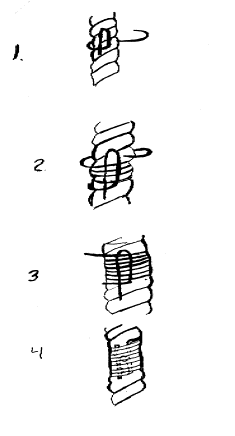
Transom knot

Transom Knot: Very similar to the constrictor knot. This is to tie perpendicular branches to each other. I have used this knot with willow bark cordage to build a primitive shelter frame.

Clove Hitch, AKA peg knot or boatman's knot: Used to fasten lines to a post or ring. It has been used on primitive fishing poles by attaching the line at intervals along the pole. Use this knot on tent pegs.

Trucker Hitch: The primitive equivalent of cinch straps. This hitch will give a two to one mechanical advantage. This works well for strapping bundles onto a backpack frame or a pack animal's saddle. Once I impressed my coworkers by using this knot to strap down some cargo in a pickup truck box. Tie off the free end with a slipped double half hitch.


Highwayman's Hitch: This is a fun one. Used for tethering horses, or lowering loads. Its advantage is the quick release. Robbers use this knot to prep for a fast getaway. If you tether critters, learn this knot.

Noose: I have used this knot to hang deer from branches while field dressing and skinning. It can be used for snaring, although I don't know anyone who has used it successfully.

Sheep Shank: This knot is used to shorten lines to the required length. If you have ever spent several hours twisting natural fibers in cordage by hand, cutting your precious cord is the last thing you wish to do. Another use is to bypass a damaged section of line.

Rope Locker, AKA Whipping: This is used to keep your nice hand twisted rope end from unraveling. This is equivalent to plastic tape or melting synthetic rope ends. Plastic tape would look out of place on a primitive rope. I like to use a single thin strip of fiber to wrap the end of my cordage. I use whipping as the arrow nocking area of my bowstring.
I have not included any fishing knots here because I have never done any angling with primitive gear. The only primitive fishing I have ever done is with a spear. If anyone has successfully used primitive angling gear, please let me know what knots and gear you were using.
Learning knots takes a bit of practice. It is one of the primitive skills that can be practiced practically anywhere, for any amount of time. I have passed hours of time in airplanes by practicing knots or a few minutes in my cubicle during lunch break. It is a skill that would serve you well in the Stone Age or the 21st century. If you are in a situation where the knot is needed right now, the time to learn was long before. It is my hope that this short piece will generate some correspondence about your favorite knots and their uses.
Knots are a large subject matter. There are probably hundreds of knots with a couple of variations on each of them, and a couple of names for each of them. The important thing is to select the right knot for the given situation.
References and links:
The Book of Outdoor Knots by Peter Owen
This Old House, Knots Homeowners Should Know by Joe Hurst-Wajszczuk
http://www.thisoldhouse.com/
Knots How To
http://www.magnacraypots.com.nz
Knot Knowledge
http://www.iland.net
Knots on the Web by Peter Stuber
http://www.earlham.edu.~peters/knotlink.htm
Ropers Knot Page by Ed Prin
http://www.realknots.com
E-mail your commits to "Bill Scherer" at scherer_william@hotmail.com
We hope the information on the PrimitiveWays website is both instructional and enjoyable. Understand that no warranty or guarantee is included. We expect adults to act responsibly and children to be supervised by a responsible adult. If you use the information on this site to create your own projects or if you try techniques described on PrimitiveWays, behave in accordance with applicable laws, and think about the sustainability of natural resources. Using tools or techniques described on PrimitiveWays can be dangerous with exposure to heavy, sharp or pointed objects, fire, stone tools and hazards present in outdoor settings. Without proper care and caution, or if done incorrectly, there is a risk of property damage, personal injury or even death. So, be advised: Anyone using any information provided on the PrimitiveWays website assumes responsibility for using proper care and caution to protect property, the life, health and safety of himself or herself and all others. He or she expressly assumes all risk of harm or damage to all persons or property proximately caused by the use of this information.
© PrimitiveWays 2013